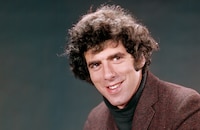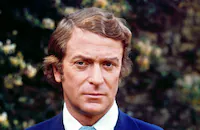Harry And Walter Go To New York
Brief Synopsis
Cast & Crew
Mark Rydell
James Caan
Elliott Gould
Seamon Glass
Kathryn Grody
Carol Kane
Film Details
Technical Specs
Synopsis
At the beginning of the 20th century, Harry and Walter are performing their third-rate vaudeville act in small towns around the country. When they are thrown in jail for petty theft, they meet the wealthy and charming bank robber, Adam Worth. Worth tells them about his plan to rob the Lowell Bank and Trust in New York. The bank has a reputation for being very secure, but Worth has gotten diagrams of the security systems while in jail. Harry and Walter decide to rob the bank themselves, get a copy of the plans, and break out of prison on the same day that Worth is paroled. Once in New York, Harry and Walter race against Worth to see who will rob the bank.
Director
Mark Rydell
Cast

James Caan

Elliott Gould
Seamon Glass
Kathryn Grody

Carol Kane
Ernie Mishko
George Gaynes
Lee Wolfberg
Karen Powell
Bert Remsen
Read Morgan
Emmett Brown
Jack Brodsky
Louise Decarlo
Selma Archerd
Christopher Rydell
Carmel Lougene

Jack Gilford
Anthony Columbia
Ellen Blake

Charles Durning
Geraldine Decker
Danny Rees
Evelyn Rydell
David Shire
Jay Thompson
Dennis Dugan
Tom Lawrence
Don Ames
James Decloss
Michael Conrad
Karlene Gallegly
Warren Berlinger
Alex Sharpe
John Hackett
Robert Miller Driscoll
Eddy Donno
Jim Nickerson
Carmine Coppola
Sherry Moore
Burt Young
George Greif

David Proval
Roger Til
Sig Froelich

Nicky Blair
Victor Romito
Dee Hoty
Yolanda Mayer
Harry Naughton
Suzanne Covington
Brion James
Val Avery
Ginny Gagnon
Philip Kenneally
Alex Rodine
Charles Murray
Ted Cassidy
Ellen Janes

Lesley Ann Warren
Ben Davidson
Colin Hamilton
Michelle Breeze
Walter Wilison
Maureen Arthur
Elizabeth Summers
Kim Lankford

Michael Caine

Diane Keaton
Michael Greene
Crew
Michele Ader
Richmond Aguilar
Theoni V. Aldredge
Richard Berger
Alan Bergman
Marilyn Bergman
Tony Bill
David Bretherton
Bobby Byrne
John Byrum
John Byrum
Rita Joelson Chidester
Fred Collins
Don Devlin
Allan Falco
David Friedman
Chuck Gaspar
Harry Gittes
Don Guidice
Harry Horner
Joseph Hurley
Robert Kaufman
Robert Kaufman
Laszlo Kovacs
Erma Levin
Ruby R Levitt
Richard Liebegott
Phill Norman
Marie Osborne
Arthur Piantadosi
James Rascoe
Kay Rose
Richard M. Rubin
Eric Seelig
Al Shenfeld
David Shire
Sheldon Shrager
Lynn Stalmaster
Frederic Steinkamp
Terry Terrill
Joseph B Thibo
Barry D Thomas
Fred L Williams
Sherry Wilson
Jerry Ziesmer
Film Details
Technical Specs
Articles
Harry and Walter Go to New York
The 1890s-set scenario follows Harry Dighby (Caan) and Walter Hill (Gould), two failed vaudevillians reduced to a carnival mind-reading con; their incompetence at fleecing the rubes invariably serves to land them in the state penitentiary. Inside, the bungling grifters make the acquaintance of a professional hero, the urbane, calculating master thief Adam Worth (Caine). With the prison administration bought and paid for, Worth lives a princely existence, and he presses the new inmates into service as his manservants. It's there that the boys make the acquaintance of Lissa Chestnut (Keaton), the editor of a socialist newspaper, who'd been granted access to Worth for an interview.
Harry and Walter inevitably stumble upon Worth's schematics for the planned heist of a bank in Lowell, Massachusetts. After photographing the plans (and accidentally destroying them in the process), the duo proceed to break jail with the intent of pulling the job themselves. Their paths again across with Lissa, who pledges the assistance of her anarchist staff in exchange for a substantial chunk of the take going to a milk fund for the poor. Worth, for his part, arranges a quiet release from prison so he can race the boys to the crime scene--and make sure they're properly repaid for their assistance.
The worst that Worth had planned for Harry and Walter couldn't have been a whole lot crueler than the response of many contemporary critics. "[I]t's so implacably cute that you might suspect it was based on a coloring book that was based on The Sting," Vincent Canby wrote in the New York Times. "It's big and blank and so faux naif that you want to hit it over the head in the way that used to bring people to their senses in true farce, of which this is no example." Variety similarly sniffed that it "may rate as the numbest and dumbest picture released in months...In a season of general mediocrity, this is the prize turkey."
For Walter Hall's 1981 Caine biography Raising Caine, Burt Young, cast as the obsequious prison warden, proffered his own theories as to why Harry and Walter Go to New York misfired. "Michael is so goddam bright, he's a total professional. But the trouble with the film was that we all hit it off too much. Everybody was patting each other on the back. I've never heard so many cries of brilliant and bravo! Sometimes a movie gets bumpy when that happens. It loses its way and nobody knows where it's going. You lose the pits and valleys for just peaks, and in the end your audience."
Producer: Don Devlin, Harry Gittes
Director: Mark Rydell
Screenplay: John Byrum, Robert Kaufman (screenplay); Don Devlin, John Byrum (story)
Cinematography: László Kovács
Art Direction: Richard Berger
Music: David Shire
Film Editing: David Bretherton, Don Guidice
Cast: James Caan (Harry Dighby), Elliott Gould (Walter Hill), Michael Caine (Adam Worth), Diane Keaton (Lissa Chestnut), Charles Durning (Rufus T. Crisp), Lesley Ann Warren (Gloria Fontaine), Val Avery (Chatsworth), Jack Gilford (Mischa), Dennis Dugan (Lewis), Carol Kane (Florence).
C-112m.
by Jay S. Steinberg

Harry and Walter Go to New York
Quotes
Adam, where'd you find those two oafs?- Chatsworth
Oh, they're not oafs, Jack. They would require practice to become oafs.- Adam Worth
Trivia
Miscellaneous Notes
Released in United States June 1976
Released in United States Winter January 1, 1976
Released in USA on video.
Released in United States Winter January 1, 1976
Released in United States June 1976













